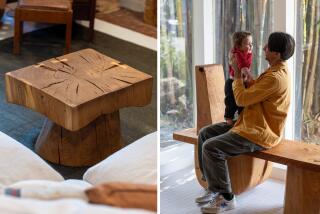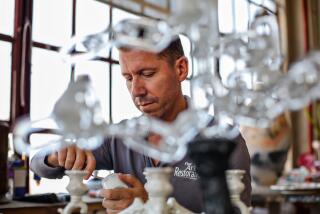The Grain of History : Artisan Makes Furniture Using Wood From Buildings of Centuries Past
CANOGA PARK â Jonas Hardy knows wood, has an abiding respect for its character, a passion to sculpt it and bring it to life. Especially old wood--the aged spruce, maple, ash and birch that once served as the carefully constructed beams, floor planks and siding of dilapidated Revolutionary War-era structures from rural Vermont and its environs.
For 16 years Hardy, a former rock band manager and photographer, has transformed a forest of centuries-old wood from barns, homesteads and carriage houses into his own handcrafted period furniture, much-sought-after products that fetch top dollar from celebrities, designers, architects and high-end retailers around the world.
Hardyâs hand-hewn tables, chairs, beds and armoires--which have sold for as much as $30,000--have ended up in some unlikely places, from a Saudi Arabian palace to homes owned by hockey star Wayne Gretzky and comedian Dan Aykroyd.
Other customers, according to Hardy, are movie moguls George Lucas and Steven Spielberg, actors Tom Selleck, Robert Redford and Tom Cruise, singers Neil Diamond and Lionel Richie, and golfer John Daly.
Produced out of a small shop in a faceless industrial corner of the San Fernando Valley, his recycled creations have even been featured on the covers of such magazines as Architectural Digest, Country Living and Metropolitan Home.
But for the gray-haired Oklahoman, who was once the road manager for the 1970s rock group Three Dog Night, the satisfaction of such success runs second to his romance with the wood itself, which--in his precise yet free-spirited vision--often takes on human qualities.
âIâve always been in love with old wood,â he said. âWood is one of the few things that grows old gracefully. It handles its wrinkles well. The tool marks and chisel cuts from 200 years ago, well, a good piece of old wood is able to carry all of it off just wonderfully.â
*
At age 59, Hardyâs is a rags-to-riches story twice told. Itâs the tale of a man who began a new career as a wood craftsman in his mid-40s--after previous ventures had left him broke--only to lose it all in the Malibu fires of 1993 when flames barnstormed his workshop, burning his entire stock of uninsured furniture.
Now, with his anonymous carpenter shop across the street from a dumpster storage lot, Hardy has set about expanding his reputation as a trend-setting craftsman.
âJonas is really the first wood artist to find old structures and recycle them into his creations,â said Andrea Lawrence Wood, a Denver interior designer who has used Hardyâs furniture in refurbishing mountain resorts from Vail, Colo., to Jackson Hole, Wyo.
âHe just understands the wood. He knows how to use massive pieces and show the woodâs simplicity and strength. What I like most about his work is that he lets the wood speak instead of using too much detail that might be distracting.â
As his small staff of artisans fits together by hand odd pieces of birch and pine under the sleepy gaze of the workshop cat, Hardy runs his hand along several 9-foot-long beams of spruce that were once the interior walls of an 18th century New England barn.
Through a tip, Hardy had learned that the barn was going to be demolished by its owner and paid to do the job himself--and salvage the wood. He deflects criticism that he is destroying historical landmarks by saying he has never brought down a barn or other building that hadnât nearly fallen down by itself.
He grasps a beam containing a joint held together, not by nails, but by an ancient-looking wooden peg.
âWhen I pull that wooden peg out of this old beam, I know that the last guy who worked on this wood did it 200 years ago--I know that heâs dead and his grandchildren are probably dead,â he said. âTo take old wood never intended as furniture and build something out of it, so it may last another 200 years, to me, thatâs just fascinating.â
But artistic carpentry wasnât Hardyâs first passion. In the 1970s, he was an aspiring singer and songwriter who worked as a music middleman, hooking up songs written by unknown writers with various bands, including Three Dog Night.
He eventually became the bandâs road manager, and, as Hardy tells it, when âthe craziness happened,â he ran off with the lead singerâs wife. They headed for the East Coast.
Somewhere along the way, he recalls, the couple stopped to ask for directions to Connecticut. âThis gas station attendant just scratched his head and said, âHell, why are you going to Connecticut? Vermont is much more beautiful.â So thatâs where we went.â
In Vermont, Hardy bought a 1790s-era farm, complete with a one-room schoolhouse and a cemetery containing the graves of Revolutionary and Civil War veterans.
Inspired by the history and the landscape, Hardy quickly fell in love with the simple, sturdy architecture of the place. He fell for the wood.
He went to antique stores and âlooked under all the tables and furniture to see how it was madeâ and read books on the subject.
With wood from his barn and an adjoining outhouse, Hardy used âa screwdriver and an old chiselâ to build a crib for his infant son Luke--his first of three boys--a little work of art complete with heart-shaped holes through which Luke âalways used to peek out at you.â
He returned to Southern California, where an interior designer encouraged him to start building furniture.
Using a picture of a 17th century table as a guide, having built nothing before but his sonâs crib, he finished his first job in three weeks and was amazed when he was paid $2,100 for the piece. âI thought an entire kitchen table with five chairs cost $179,â he said. âThen I saw my table sitting on a $10,000 carpet under a $10,000 chandelier and something clicked.â
Working outdoors at his Topanga home, he began designing and making his own furniture, including an armoire he saw in a dream. Like craftsmen who came before him, Hardy says, he built out of necessity: He needed the money.
*
âEverything he does is unique--itâs a piece of art,â said San Francisco architect Howard Backen, who uses Hardyâs work in his projects. âYou get the feeling that this manâs talents somehow come right out of the 18th century. Itâs truly impressive.â
Hardyâs philosophy is not to violate the woodâs past. âThe idea is not to take it too far,â he said. âEvery time you sand off even a little bit, youâre sanding off decades of character. If thereâs a tool mark there, you want to keep it. Under the dust and the dirt and the horse manure is a picture of a world that is virtually gone.â
By 1993, Hardy was bringing five truckloads of Vermont wood out west each year. He had a bustling little workshop in Malibu. Then came the fires.
He recalls the flames looming, knowing there was no time to rescue his work. Finally, he told his son Robben that it was time to go. âI closed the doors real slow, taking a mental picture of those pieces. I knew Iâd never see them again.â
Uninsured, flat broke, Hardy started again. Loyal customers helped him reestablish his business quickly.
But no matter how many pieces he sells, his favorite will forever remain his first.
âNothing,â he says, âcould ever match the satisfaction of building that little crib. Itâs one of a kind.â



